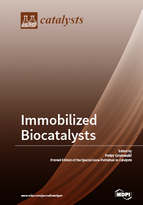Immobilized Biocatalysts
A special issue of Catalysts (ISSN 2073-4344). This special issue belongs to the section "Biocatalysis".
Deadline for manuscript submissions: closed (31 March 2018) | Viewed by 232823
Special Issue Editor
Interests: biocatalysis; enzymatic analysis; Environmental biotechnology
Special Issues, Collections and Topics in MDPI journals
Special Issue Information
Dear Colleagues,
Biocatalysts—single enzymes or whole cells—have gained increasing importance in the last few decades as green alternatives to their chemical counterparts for a variety of industrial processes. They catalyze reactions with the advantage of superior chemo-, regio-, and stereo-specificity at mild conditions, thereby avoiding the production of larger amounts of waste. To prevent spoiling of the resulting products with protein the biocatalysts should be employed in an immobilized form. In contrast to the application of soluble enzymes, they enable a higher volume specific biocatalyst loading together with simplified downstream processing. In addition, they can be reused tantamount to reducing cost contribution to the final product. Immobilization may also contribute to an enhanced storage and operational stability compared to soluble biocatalysts.
Immobilized biocatalysts are—apart from application in the chemical/pharmaceutical industry—used as biosensors, in medical diagnoses, genomics and genome sequencing (next generation sequencing), for protein microarrays (tracking interactions and activities of proteins, drug screening, etc.), or enzyme biocomputing.
The activity (efficiency) of an immobilized biocatalyst depends on various properties of the carrier material such as particle size and shape, its chemical nature, density, porosity (mass transfer limitation of the compounds involved), pore-size distribution or the mechanical strength. In addition, suited immobilization supports aside from bearing functional groups on their surface should be hydrophilic, biocompatible, resistant to microbial attack, and readily available at a low cost. They are of inorganic or organic origin and include natural and synthetic polymers. Bioinspired scaffolds and nanostructured materials (nanoparticles (paramagnetic), nanofibers, nanotubes, graphene, nanocomposites) are also used for enzyme immobilization.
Traditional immobilization techniques comprise adsorption, covalent binding, crosslinking, and entrapment. Moreover, immobilization and chemical modification may be coupled with site-directed mutagenesis, and nanobiocatalysts are generated by biological assembly methods. For covalent, site-specific immobilization several chemical and enzymatic approaches have proven. A variety of surface analysis technologies exist to control enzyme immobilization.
Prof. Dr. Peter Grunwald
Guest Editor
Manuscript Submission Information
Manuscripts should be submitted online at www.mdpi.com by registering and logging in to this website. Once you are registered, click here to go to the submission form. Manuscripts can be submitted until the deadline. All submissions that pass pre-check are peer-reviewed. Accepted papers will be published continuously in the journal (as soon as accepted) and will be listed together on the special issue website. Research articles, review articles as well as short communications are invited. For planned papers, a title and short abstract (about 100 words) can be sent to the Editorial Office for announcement on this website.
Submitted manuscripts should not have been published previously, nor be under consideration for publication elsewhere (except conference proceedings papers). All manuscripts are thoroughly refereed through a single-blind peer-review process. A guide for authors and other relevant information for submission of manuscripts is available on the Instructions for Authors page. Catalysts is an international peer-reviewed open access monthly journal published by MDPI.
Please visit the Instructions for Authors page before submitting a manuscript. The Article Processing Charge (APC) for publication in this open access journal is 2700 CHF (Swiss Francs). Submitted papers should be well formatted and use good English. Authors may use MDPI's English editing service prior to publication or during author revisions.
Keywords
- Immobilized Biocatalysts, application areas (industrial production of goods and chemicals, pharmaceuticals, biofuel) analytics, diagnoses, microarrays, biocomputing, biofuel cells, bioactive coatings
- Immobilization techniques, -traditional, site-specific protein immobilization, enzyme-mediated immobilization, biological assembly methods, cascade reactions, protein scaffolds, self-assembly of enzyme nanostructures, multi-enzyme immobilization, immobilization and site-directed mutagenesis
- Immobilization supports, -properties, (quantum dots, magnetic nanoparticles, nanorods, nanotubes, nanofibres, nanocomposites
- inorganic and organic materials, natural and synthetic polymers), biosynthesis of nanoparticles
- surface analysis technologies (atomic force spectroscopy, FRET, BRET, TEM, SPR, and others)
- kinetics of immobilized biocatalysts.
Related Special Issue
- Immobilized Biocatalysts, 3rd Edition in Catalysts (1 article)






